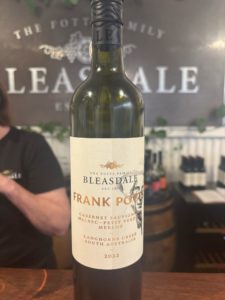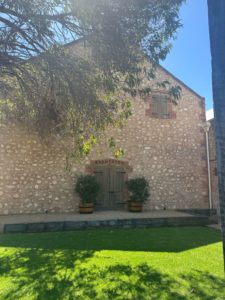Home to the traditional Ngarrindjeri people, Langhorne Creek has evolved into a thriving agricultural hub, where multi-generational families, forward-thinking businesses, and new-generation artisans collaborate to craft award-winning wines, cultivate high-quality produce, and nurture prized livestock. The region’s fertile floodplains and innovative viticulture make it a prime location for premium winemaking. However, what truly sets Langhorne Creek apart is its deep connection to the land, its people, and its commitment to inclusivity, both in its historical development and in how its wineries welcome diverse visitors today.
Langhorne Creek’s wine story dates back to the mid-19th century when European settlers, including English shipwright Frank Potts, recognised the potential of the region’s alluvial soils and natural water supply. Potts planted the first vines in the 1850s, laying the foundation for what would become a thriving wine industry. Over time, the community developed a unique irrigation system harnessing natural flooding from the Bremer River, ensuring a steady water supply for vineyards. This cooperative approach remains at the heart of Langhorne Creek’s viticulture today.
Floodplain viticulture is a defining feature of the region. The shared water system, using floodgates to distribute water evenly across properties, echoes the dyke systems of the Netherlands. Having lived in the Netherlands, I’ve seen firsthand how communities successfully manage and share water resources, just as Langhorne Creek’s growers have done for generations. However, climate change has altered this dynamic, with the last major flood occurring in 2012. Historically, these floods would temporarily close the town, with families navigating by boat or jet ski, reinforcing the region’s strong community bonds. In response to environmental shifts, local growers are now implementing sustainable practices, lowering carbon emissions, and adopting regenerative farming techniques to safeguard the future of their viticulture. This commitment to resilience and sustainability underscores Langhorne Creek’s forward-thinking spirit.

Langhorne Creek’s wineries are dedicated to ensuring that wine experiences are for everyone.
As one of Australia’s oldest family-owned wineries, Bleasdale Vineyards honours tradition while making wine accessible to all. Their tasting experiences cater to everyone, from connoisseurs to first-time tasters, ensuring a welcoming environment. Bleasdale holds a special place in the region’s history, being the original winery established by Frank Potts and the first to plant Malbec, now a signature variety of Langhorne Creek. Visitors can still view the historic 1862 wooden wine press, constructed from native river red gums, which remains a testament to the winery’s heritage.

Lake Breeze, having won the 2022 Best Of Wine Tourism Award for Architecture and Landscape, embodies inclusivity, offering a welcoming, family-friendly atmosphere. Their on-site restaurant caters to diverse dietary preferences, including vegetarian, vegan, and gluten-free options. The winery is fully wheelchair accessible and plays a crucial role in fostering community spirit by hosting the annual Handpicked Festival. Since its inception in 2014, the festival has grown from 2,500 attendees to 7,500 in 2024, highlighting its broad appeal. With a lineup of local and international artists, the festival brings families and people of all ages together to celebrate music, wine, and culture. Beyond their own operations, Lake Breeze supports their family on Kangaroo Island, assisting with winemaking tasks like destemming and pressing. They also grow Pecorino, the only one of its kind in the region, showcasing Langhorne Creek’s ability to embrace diverse grape varieties.
Sisters Rebecca and Lucy Willson lead Bremerton Wines, exemplifying female leadership in the wine industry and notably the first female run winery in Australia. Their inclusive philosophy extends to their broad portfolio, which includes alternative varieties like Vermentino alongside classic Shiraz. The cellar door’s relaxed vibe invites guests to explore diverse wine styles. Bremerton was also the first in the region to plant Verdelho, reinforcing Langhorne Creek’s reputation for innovation. Their marketing leans into highlighting the beauty of classic winemaking alongside fresh, unconventional approaches. Their father, a progressive advocate for gender equality, instilled in them the belief that winemaking was not just for men, an ethos that continues to shape the winery today.

Kimbolton Wines is redefining their cellar door experience with innovative, accessible offerings. They work with seven grape varieties, crafting multiple styles of Montepulciano to highlight its versatility. Their visual tasting cards cater to those with dyslexia, ensuring that everyone can engage with the wine experience. Sustainability is also a priority, with wine in cans catering to campers and outdoor enthusiasts. Their award-winning cellar door, which has won both the 2020 Best Of Wine Tourism Award for Architecture and Landscape, and the 2025 Best Of Wine Tourism Award for Wine Tourism Services, is designed for accessibility, welcoming visitors of all abilities. To encourage regional tourism, they’ve partnered with wineries in McLaren Vale and Adelaide Hills, offering incentives for visitors to explore multiple wine regions in a single day.
WindSong Wines is more than a cellar door, it’s a hub for creativity and sustainability. The winery showcases works from emerging artists, hosting exhibitions that merge wine and art. Their eco-conscious vineyard minimises chemical use, fostering biodiversity and natural vineyard health. WindSong offers an inclusive space where wine lovers, artists, and sustainability advocates come together to share in a unique, immersive experience
The Winehouse brings together wines from multiple producers, creating a relaxed space where guests can sample the best of Langhorne Creek under one roof. They champion low-intervention and organic wines, catering to sustainability-conscious drinkers. Their family-friendly venue includes a restaurant, a kids’ area, and even lawn bowls, making it ideal for all visitors. The addition of Meechi Brewing, named after the Indigenous word for the Bremer River, expands their offerings beyond wine to locally crafted beer, further reinforcing their commitment to inclusivity.
While Langhorne Creek produces exceptional Shiraz and Cabernet Sauvignon, Malbec has emerged as the region’s defining grape. Introduced over a century ago, it has thrived in the region’s unique terroir, producing deeply coloured wines with plush dark fruit flavours and velvety tannins. Wineries are experimenting with modern techniques such as carbonic maceration and amphora ageing, broadening Malbec’s appeal. The grape’s resilience to climate change ensures that Langhorne Creek remains a leader in premium Australian wine production.
A Region Open to All
Langhorne Creek’s commitment to accessibility extends beyond its wineries. The region offers free caravan parking, ensuring that visitors of all budgets can experience its charm. This welcoming ethos sets it apart from more exclusive wine regions, making it a favourite for travellers seeking a down to earth yet world class wine experience.
One of the most exciting regional initiatives is Grapes for Good, which won the 2023 Global Best Of Wine Tourism Award for Innovative Wine Tourism Experiences. This partnership between six Langhorne Creek wineries and Zoos SA supports conservation efforts, demonstrating the power of wine tourism to drive positive change.
Whether you’re a seasoned connoisseur, a casual visitor, or an advocate for sustainability and inclusivity, this welcoming community of Langhorne Creek ensures that a wine experience is for everyone.
This blog is written by Teri van Aalst, the Wine Communicators of Australia Wine Media Cadet. The cadetship is supported by the Great Wine Capitals Adelaide, South Australia chapter, which is a partnership between the Government of South Australia (South Australian Tourism Commission and the Department of Primary Industries and Regions), the South Australian Wine Industry Association, and the University of Adelaide. Thanks to the Langhorne Creek Wine Region Association for hosting Teri.
Photos: Teri van Aalst; Bremerton Wines, Fleurieu Peninsula